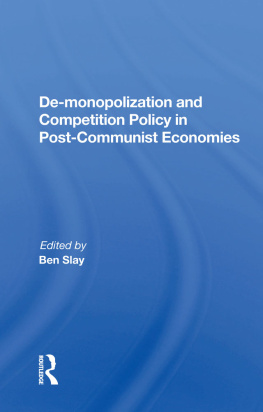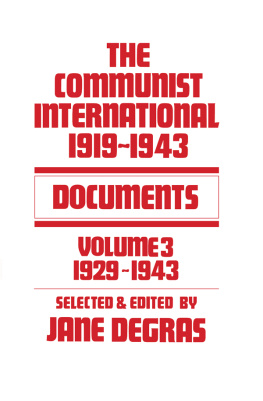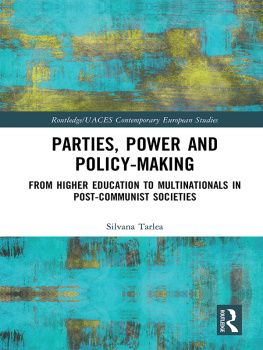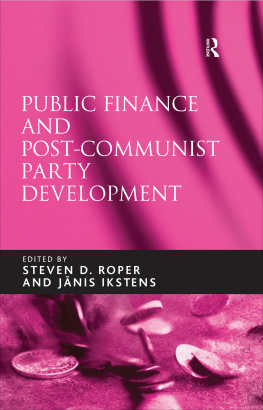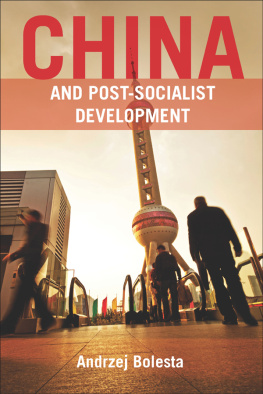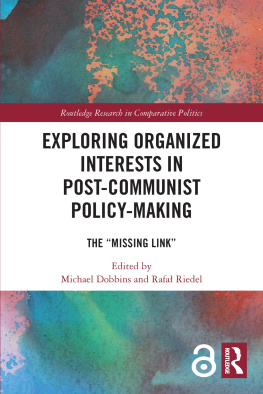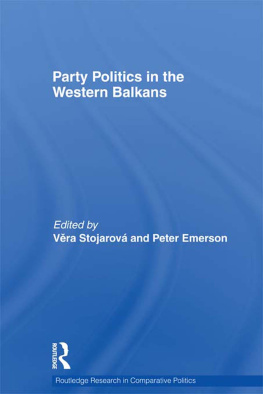De-monopolization and Competition Policy in Post-Communist Economies
De-monopolization and Competition Policy in Post-Communist Economies
Edited by
Ben Slay
First published 1996 by Westview Press, Inc.
Published 2018 by Routledge
52 Vanderbilt Avenue, New York, NY 10017
2 Park Square, Milton Park, Abingdon, Oxon OX14 4RN
Routledge is an imprint of the Taylor & Francis Group, an informa business
Copyright 1996 Taylor & Francis
All rights reserved. No part of this book may be reprinted or reproduced or utilised in any form or by any electronic, mechanical, or other means, now known or hereafter invented, including photocopying and recording, or in any information storage or retrieval system, without permission in writing from the publishers.
Notice:
Product or corporate names may be trademarks or registered trademarks, and are used only for identification and explanation without intent to infringe.
Library of Congress Cataloging-in-Publication Data
De-monopolization and competition policy in post-communist economies / edited by Ben Slay.
p. cm.
Includes index.
ISBN 0-8133-8864-3 (hardcover)
1 . PrivatizationEurope, Eastern. 2. PrivatizationRussia (Federation) 3. Government monopoliesEurope, Eastern. 4. Government monopoliesRussia (Federation) 5. Post-communism. I. Slay, Ben. 1958- .
HD4140.7.D425 1996
338.947dc20
95-49745
CIP
ISBN 13: 978-0-367-01685-2 (hbk)
Contents
, Ben Slay
, ldm Trk
, Vladimir Capelik and Ben Slay
, William E. Kovacic and Robert S. Thorpe
, Ben Slay
, Janusz A. Ordover, Russell W. Pittman, and Paul Clyde
, Erik Whitlock
, Ben Slay
Guide
While the list of individuals and organizations that supported or contributed to the creative processes that led to the publication of this volume is too extensive to be justly recorded here, a number deserve special thanks. In addition to the contributors to this volume itself, thanks go to Cindy Alexander, Josef C. Brada, Timothy J. Brennan, Gregory Brock, Jon Cauley, Christopher Clague, Cynthia Clement, Jay Creswell, Paul T. Denis, Michael Einhorn, Mary E. Fitzpatrick, Barry Freeman, Clive Gray, Gary Hewitt, Ryszard Hoffman, Jim Hughes, Barry Ickes, Andrej Juris, Georges Korsun, Jim Leitzel, Michael Marrese, Peter Murrell, Richard P. O'Neill, Armando Rodriguez, Gerald Sazama, John Tedstrom, Peter van der Hoek, Ferenc Vissi, Michael Ward, Spencer Weber Waller, and Robert D, Willig, for commenting on this volume in its various previous incarnations. Gratitude is also expressed to the American Council of Learned Societies, the LICOS Institute of the Catholic University of Leuven, the Open Media and Radio Free Europe/Radio Liberty Research Institutes, the Social Science Research Council, the University of Maryland's Program for Institutional Reform of the Informal Sector, and the United States Agency for International Development for supporting the research on which this volume is based. Thanks also go to Fritz Burkhardt and Judy Olinick, for printing and organizational assistance.
On a more personal note, I would like to thank my father, Charles Slay, from whom I learned my first lessons about business and antitrust, and my wife and daughter, Liza and Amy, for putting up with my prolonged absences necessitated by this project. I would also like to thank Susan McEachern at Westview Press, for her early and unflagging support. Last but not least, a large debt of gratitude is owed to the men and women of the competition offices in Russia, Eastern Europe, Mongolia, and elsewhere, who took time out from their arduous and often thankless labors to share insights and information with the contributors to this volume.
Ben Slay
1
From Monopoly Socialism to Market Capitalism
Ben Slay
On "Monopoly Socialism"
With the exception of natural monopoly factors, where advantages of size and scope make production by a few large firms less costly to society than production by many smaller firms, there is little disagreement about the importance of competitive markets for well-functioning capitalist economies, or about the need for some sort of competition policy to promote and maintain those competitive markets. By contrast monopoly, understood as the absence of competitive market forces, has been the subject of near-unanimous condemnation by Western economists for more than two centuries. By producing less and charging a higher price than would be the case under competitive conditions, monopoly in a static sense is associated with allocative inefficiency. Monopoly may also be associated with technical and X-inefficiency, in that short-run disincentives to selecting cost-minimizing output levels and production methods, as well as long-run disincentives to innovate and promote technological progress, may be linked to monopoly. Finally, Marxian critics of markets have argued that undesirable concentrations of economic and political power are associated with "monopoly capitalism."
Not only is the undesirability of monopoly one of the few issues on which Western economists find themselves in near-total agreement, it is also one of the few areas of Western economics that has been wholeheartedly accepted and applied in transitional economies. While policy makers in these economies may have reservations about adopting orthodox macroeconomic stabilization programs or privatizing thousands of state enterprises, the neoclassical condemnation of monopoly has been adopted-and often extended-almost universally throughout the post-communist world. De-monopolization has generally been viewed as a key element of any successful transition from socialism to capitalism, especially in industry. The passage of competition laws and the creation of competition agencies were often among the first tasks market-oriented governments set for themselves in the early 1990s, while advice from Western competition policy makers has been frequently proffered (and often accepted).
When viewed in historical perspective, however, these developments are something of a novelty. Monopoly under Soviet-type socialism was not widely perceived as a problem until the late 1980s, and was rarely investigated before then.
More concretely, it was frequently argued that the Soviet-type approach to industrial organization produced high degrees of structural concentration. Although the exact course of developments differed by country and time period, the general pattern behind this concentration began with an initial assault on the private sector that drove entrepreneurs underground or to the margins of economic life. The large-scale nationalization of private firms and property (or their forcible collectivization, accompanied by the etatization of cooperative movements) was followed by increased structural concentration within the state and cooperative sectors, often as a result of centrally-directed horizontal and vertical mergers among firms in these sectors.
As Brown, Ickes, and Ryterman have pointed out, however, the case for high levels of structural concentration in Russia is actually much weaker than was long thought, and is in fact poorly served by arguments about average enterprise size. According to their study, industrial concentration levels in Russia during the second half of the 1980s were similar to US levels, while the average size of Russian enterprises was smaller (and frequently much smaller) than enterprises in developed capitalist economies. However, although international comparisons of concentration data are difficult to interpret, similar results are unlikely to be forthcoming for the other economies examined in this volume (i.e., Hungary, Mongolia, and Poland). The Russian economy's vast size implies the presence of many more enterprises (and therefore potential competitors) in any given industry or branch, while in the other, smaller economies considered here, such potential competition is more likely to be supplied via international trade than from domestic sources.

